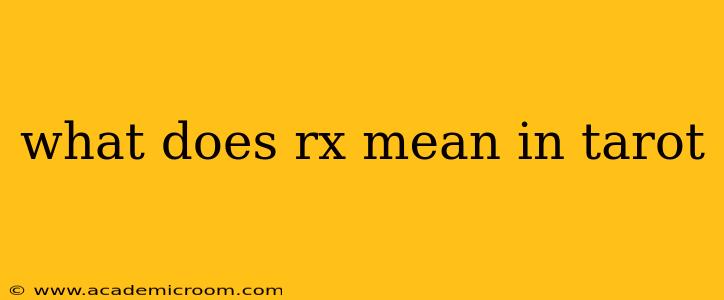What Does RX Mean in Tarot?
In the world of tarot, "RX" is a common abbreviation that signifies a reversed card. This doesn't mean the card is upside down in a literal sense; rather, it indicates a shift in the card's usual meaning. Understanding reversed cards adds a layer of complexity and nuance to a tarot reading, offering a deeper insight into the situation being explored. But what exactly does it mean when a card appears reversed? Let's delve into the intricacies.
What are reversed cards and how do they change the meaning?
The interpretation of reversed cards is a topic of ongoing debate among tarot readers. Some readers don't use reversed cards at all, preferring to focus solely on the upright meaning. Others find that reversed cards offer valuable additional context, suggesting challenges, delays, internal struggles, or shadow aspects related to the card's upright meaning.
Generally, when a card appears reversed, its core meaning is still relevant, but it often represents:
- Challenges and obstacles: Instead of a straightforward path, the reversed card may highlight potential difficulties or setbacks.
- Internal struggles: The reversed card might indicate internal conflicts, self-sabotage, or unresolved issues within the querent (the person the reading is for).
- Shadow aspects: It could bring to light hidden aspects of the situation, perhaps revealing subconscious motivations or hidden fears.
- Delayed progress: The reversed card may suggest delays or postponements in achieving the outcome associated with the upright meaning.
- A need for introspection: Reversed cards often urge the querent to look inward, examine their actions, and address any inner conflicts.
It's crucial to remember that reversed cards don't automatically mean "bad" news. They simply offer a different perspective on the situation, often highlighting areas requiring attention or adjustments.
Does the position of the card matter?
While the RX designation is crucial, the position of the reversed card within the spread also holds significance. For example, a reversed card in a position signifying the past might indicate unresolved issues from the past impacting the present. In a position representing the future, it might suggest potential obstacles to overcome. The context of the entire spread is vital for interpreting the reversed card accurately.
How do I interpret a reversed card?
Interpreting a reversed card requires careful consideration of both its upright and reversed meanings. Begin by understanding the upright meaning of the card. Then, consider how the potential challenges, delays, or inner conflicts suggested by the reversed meaning might influence the situation. The best approach is to combine your intuitive understanding with research on specific card meanings in both upright and reversed positions.
What if I don't understand reversed cards?
If you're a beginner or uncomfortable using reversed cards, it's perfectly acceptable to focus solely on the upright meanings. Many skilled readers choose this approach, finding that the upright meanings alone provide sufficient insight. As your experience grows, you can decide whether incorporating reversed cards enhances your readings.
What are some examples of reversed cards and their interpretations?
Let's take the example of the The Lovers card. Upright, it often represents harmony, relationships, and choices. Reversed, it might indicate relationship conflict, disharmony, difficult choices, or even a lack of commitment. Each card presents a unique nuance when reversed. Exploring various tarot books and websites dedicated to specific cards can deepen your understanding.
By carefully considering the overall context of the reading and the nuances of both upright and reversed meanings, you can gain a more comprehensive and insightful interpretation of your tarot spreads. Remember, practice and intuition are key to mastering the art of reading reversed cards.
